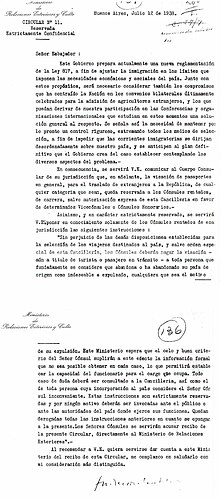Directive 11
The directive 11 was one of Argentina's Foreign Minister José María Cantilo issued in 1938 to all embassies of the country statement, European Jews Visa to refuse to travel to Argentina.
The historian Beatriz Gurevich found the only copy of the order in the archives of the Argentine embassy in Stockholm . It was published by the journalist Uki Goñi in his book Odessa . On June 8, 2005, the secret directive was canceled in a symbolic act in the presence of the Argentine President Néstor Kirchner and Foreign Minister Rafael Bielsa .
background
On July 12, 1938, the Argentine Foreign Minister José María Cantilo signed the 11th circular of 1938. It instructed the Argentine diplomatic missions abroad to refuse entry to Argentina to anyone who can be assumed to have left their country of origin or want to leave because they are considered undesirable or have been expelled from the country, regardless of the reason for their deportation. Circular 11/1938 was a restrictive instruction on issuing visas .
At the Évian Conference from July 6, 1938 to July 15, 1938, the ambassador of the Argentine government, the Liberal, Tomás Le Breton, postulated that in relation to the population, more Jews immigrated to Argentina than to the USA. The Argentine Foreign Ministry reported unofficially that Argentina had already accepted 8,000 refugees from the German Reich, which was estimated to be more than enough. At the end of July 1938, the government announced decree 8972 that from October 1, 1938, people without Argentine citizenship would have to present an entry permit from the migration authorities. In mid-1939, Esmond Ovey learned informally that the Argentine government had stopped issuing visas to Jews. Investigations by the British embassy confirmed this notification, but the Argentine government refused to make the relevant instruction public.
effect
Documented entry by ship in the second and third class of German speakers via the port of Buenos Aires to Argentina in the década infame rose until 1938 with a slump in 1935 and then fell.
| year | Second and third class passengers who reported Judaism as their religion on arrival in Buenos Aires |
|---|---|
| 1941 | 2006 |
| 1942 | 60 |
| 1943 | 26th |
| 1944 | 1 |
The Circular 11 also formally inhibited the immigration of skilled workers from Europe, which was forced by Juan Perón . To counteract this, in 1946 at the beginning of Eva Perón's tour of Europe, the racist anthropologist Santiago Peralta , replaced by Pablo Diana as head of Dirección General de Migración , founded the Delegación Argentina de Inmigración en Europa (DAIE) and agreed with the Italian government that the DAIE has an office in Italy. The Convenio Aregentino Alemania Occidental agreed on July 31, 1950 with a corresponding accounting unit favored the transfer of Nazi war criminals and “Aryanized” assets to Argentina.
literature
- Uki Goñi : Odessa. The true story. Escape aid for Nazi war criminals. Translated from the English by Theo Bruns and Stefanie Graefe. Association A, Berlin et al. 2006, ISBN 3-935936-40-0 .
- Diana Wang : The hidden children. From the Holocaust to Buenos Aires. From the Argentine Spanish by Sylvia Carmen Degen. Berlin 2012, ISBN 978-3-942271-72-1 .
Web links
- Inconvenient questions to government agencies
- Sixty years after WWII, Argentines want answers about ministry's role (English)
Individual evidence
- ↑ From the podium, Tomas Le Breton, now Argentina's ambassador in Paris, argued that Argentina had absorbed more Jews per capita than had the United States and many more than all the other Latin American countries. Nach: Haim Avni, Argentina and the Jews: a history of Jewish immigration, 1991, 267 S, p. 143.
- ^ Ronald C. Newton, The "Nazi menace" in Argentina, 1931-1947 p. 151.
- ^ Daniela Höchtl, Buenos Aires - a new home? - The integration of German Jews in the Argentine capital 1933-1939
- ↑ after Uki Goñi , Odessa: the true story; Escape aid for Nazi war criminals p. 54.
